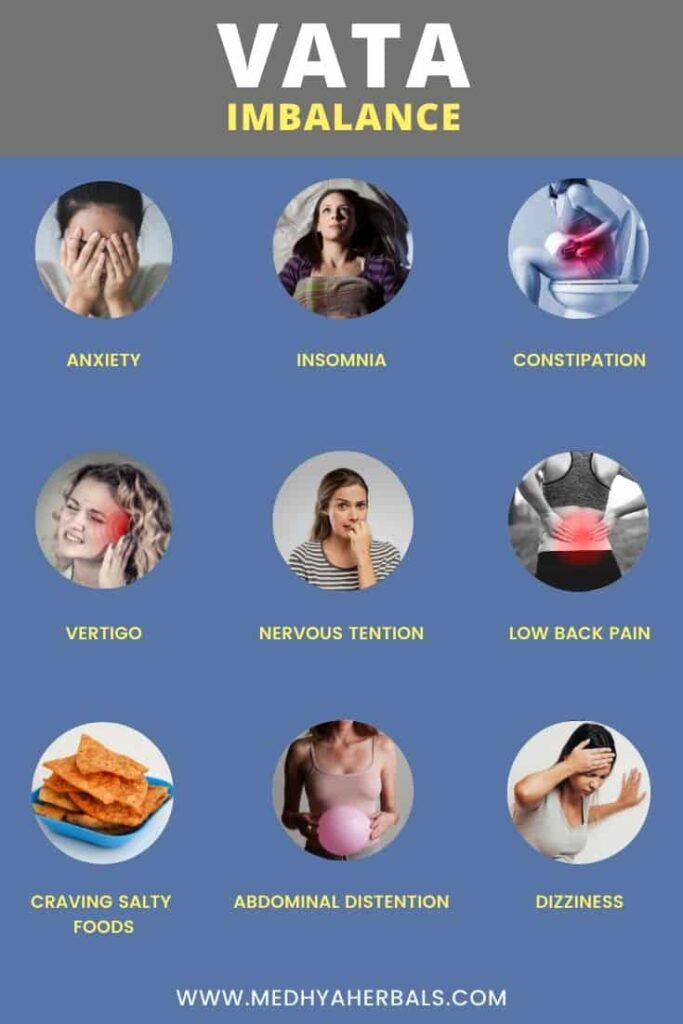Vata Imbalance poorly affects circulation and movement in the body. An imbalanced Vata Dosha can take toll on the functioning of our critical body systems such as Lymphatic system, Reproductive System, Blood Circulation, and our Mental Balance.
Vata imbalance causes to erratic bowel movement, roughness, dryness, hardness, irregular flow, or blocked flow of fluids and matter in the body. Vata increase can cause excessive, sharp, and throbbing pains in the head, stomach, or other affected body parts.
In this post you will learn about the causes and symptoms of vata imbalance. We will also look into vata dosha pacifying diet, yoga and lifestyle routine to balance your health in the Ayurvedic way!
1. Health Issues of Vata Imbalance in Women
The primary body organ or seat of Vata Dosha is the colon and pelvic cavity. Vata Dosha is responsible for all functions related to elimination. For example, elimination of urine, stools, menstruation and delivery of a baby during labour.
That’s why, Vata Imbalance often leads to health disorders such as constipation, flatulence, urinary incontinence, prolonged labour, and irregularities. Here are the health symptoms of Vata Imbalance in women.
- Irregular Menstrual cycle, Absence of Menstruation, Excessive Menstrual pain, and Menstrual Disorders.
- Hormonal Imbalance – Ovarian Cysts, Hypothyroidism, Hot Flashes, PMS, and Menopausal Syndrome.
- Carpal Tunnel Syndrome
- Low libido and lack of interest in sex and intimacy
- Poor Fertility and inability to hold the fetus.
- Prolonged Labour, Excessive Constipation during and after pregnancy
- Organ prolapse such as uterus and vagina
- Skin dryness externally and thinness of vaginal walls
- Emotional hypersensitivity and Crying Spells

2. Vata Imbalance causes Accelerated Aging in young and Health complications in Elderly
Vata Dosha is active in physical body during later years in life, ideally from 55 years onwards. That’s why any imbalance in Vata Dosha leads to musculoskeletal pains, bone weakness, and anxiety.
- Poor Bone Health , and Tendency for fractures
- Anxiety, Nervousness, Fear, Loneliness, and Spaciness
- Loss of taste buds sensitivity. Hence, inability to experience all the tastes and stimulation of food, smell, and noise.
- Hearing problems and vocal problems.
- Loss of hair, thinness of hair, and bald patches.
- Organ prolapse
- Emotional hypersensitivity
- Joint pain, Arthritis, and back pain involving Lumbago and Sciatica
- Neuromuscular disorders such as Parkinson’s and Alzheimer’s Disease
- Poor skin tone, wrinkles, excessive dry skin and lips
- Brittle nails, crooked teeth, and irregular shape of body
- Poor Immunity, Allergies, and regular infections
3. Vata increase leads to Poor Nervous System Health, Low Memory, and Focus
Vata Dosha guides the functioning of nervous system through nervine impulses. All the health issues related to nervous system originate with vitiated Vata.
- Poor Memory, Inability to recall and remember the things
- Lack of focus and inability to pay attention to the details
- Fidgetiness and restless experienced in terms of daily thoughts and long term behaviour
- Hyperactivity in children and health issues related to ADHD
- Highly emotional and vulnerable to surroundings and people. Lack of focus and emptiness in thoughts.
- Insomnia in the form of inability to sleep.
4. Vata Increase leads to Bloating, Flatulence, and Constipation
- Dryness in terms of constipation and irregular bowel movement.
- Dry and hard stools
- Lack of sweating
- Excessive weight loss or weight gain (when unbalanced Vata displaces Kapha)
- Gas, Bloating, Distention, Constipation, Flatulence, and IBS.
- Poor absorption of nutrients due to weak digestive fire.
5. Vata Imbalance causes Irregular Digestion
Usually, vata imbalance is reflected as an unpredictable digestion and an irregular appetite!
For example, a person would suddenly feel an irresistible bout of hunger, but then gets satisfied with a small quantity of food. And at other times, a person with Vata Imbalance would have no or low appetite.
An irregular digestion also is reflected as periods of constipation and diarrhea. And it involves the usual suspects – bloating and flatulence! In Ayurveda, Vata type of digestion is called vishama agni.
An irregular digestion leads to nutritional deficiencies and related health problems even if a person is consuming healthy foods.
Medhya Herbals
Hence, it is important to balance the irregular digestion first, before one dives into good foods or bad foods!

What are the primary causes for Vata Imbalance?
Vata imbalance can occur due to various reasons such as Time, Ahara – Food and Vihara – Lifestyle, and Vichara – Mental State. Some of the reasons are listed below:
1. Kala – Time of the Day, Season, and Your Age affect Vata Balance
- Physical changes observed during Menarche, Menopause, and Post Delivery.
- Vata Dosha is active during the cold and dry months of Autumn season. This is the time, when it gets easily vitiated. Hence, one needs control consumption of cold and dry foods and limit irregularities in their daily schedules.
- Old age is related to the physical and mental aspects of Vata phase of life.
- During the day, Vata Dosha is active from 2 AM to 6 AM and from 2 PM to 6 PM. This is the time when Vata imbalance becomes aggravataed. For example, one would find early morning and early evening times when joint stiffness, pains, nervousness, anxiety build up.
2. Ahara – Food and Dietary Habits that cause Vata Imbalance
- Excessive consumption of old and leftover food
- Excessive consumption of Dry or raw food
- Insufficient food intake
- Eating very fast without proper chewing or ingestion in a standing position.
3. Vihara – Lifestyle Practices that cause Vata Imbalance
- Sudden or excessive changes in lifestyle involving meal composition, timings, and way of ingestion.
- Extreme climatic conditions involving very cold and hot temperatures.
- Multi-tasking – Involvement in multiple activities at the same time
Irregular schedule with untimely meals, erratic sleep and wake cycles. - Suppression of urges such as urination, defecation, sneezing, belching, flatulence, and or sexual urges.
- Staying up late at night and insufficient sleep poorly affect our Circadian Rhythms leading to Vata Imbalance.
- Overexertion of the body through physical work or exercise.
4. Vichara – Mental State affects Vata Balance
- Excessive Stress and Anxiety
- Worry, fear, and loneliness
- Sadness and trauma
- Overstimulation of the senses
Ayurvedic Tips for Vata Dosha Balance
As easy it is to get unbalanced; it is also easy to come back in place by following a simple rule of discipline and regularity.
The guiding principle of balancing Vata Dosha is as simple as practicing directly opposite characteristics of Vata. Ayurveda prescribes numerous methods involving dietary changes, lifestyle practices, yoga and pranayama routines, meditation, and external treatments of massage, and aromatherapy.

Vata Pacifying Diet – Foods, Herbs and Dietary Habits
Foods and diet to balance Vata dosha involves timely, nutritious and unctuous meals. In fact, freshly prepared and regular meals is the first principle to pacify vata dosha imbalance with diet.
Vata is cooling and dry in nature. Therefore, it is balanced by opposing qualities of heat and wetness or oiliness.
Ayurvedic guidelines direct towards a generous use of warming spices and herbs. Make sure, there is no chili as it stimulates Vata too much. This further causes many more health issues.
Now, herbs and spices ensure proper digestion of heavy food items. Here are the dietary guidelines for Vata Dosha balance.
- Prefer smaller meals during the day and do not hold hunger. Always take timely meals at fixed time everyday.
- Take warm and unctuous foods such as porridges, curries, gruels, and soups.
- Include spices and herbs to maintain healthy digestive fire and to get the micronutrients.
- Remove chilli and sugar from the diet. Both of these cause excessive stimulation and push Vata out of balance.
- Remove cold temperature foods and drinks.
- Limit or stop raw foods such as salads.
Lifestyle Practices for Vata Balance
- The most important act to balance Vata includes a daily routine. Establish and follow a schedule around your activities, sleep and meals intake.
- Vata imbalance needs good rest. Sleep of 8-9 hours is required. Do not hold on to sleep and do not reduce sleeping hours.
- Remove all the Vata aggravating factors that were mentioned earlier.
- Regular self-massage by warming oils such as sesame oil and ghee. In Ayurveda, it is known as Abhyanga.
Physical Activity to Balance Vata Dosha
- Practice calming and soothing activities such as swimming and walking in nature. They can help to relieve Anxiety, Nervousness, and Loneliness feelings.
- Avoid excessive physical activity. It can lead to vata aggravation and related health disorders.
- Practice lower intensity exercises. Focus on strength building and balancing activities such as yoga, tai chi, qi gong.
- Pranayama (breathing exercises) and regular meditation are highly balancing for vata dosha.
Yoga Poses for Vata Imbalance
Vata imbalance benefits from strength building poses. Practice yoga sequences that promote balance and controlled breathing. It helps to calm down mobile and light characteristics of Vata.
Note: Inversion yoga poses are not advised during menstrual cycle and during pregnancy.
- Surya Namaskar – Sun Salutation Sequence
- Adho Mukha Svanasana or Wall Push
- Tadasana – Mountain Pose
- Utkatasana – Chair Pose
- Trikonasana – Triangle Pose
- Savasana – Corpse Pose
- Marichyasana – Marichi’s Pose
- Balasana – Child’s Pose
- Halasana – Plow Pose
- Parsvakonasana – Extended Side Angle Pose
Pranayama | Breathing Exercises for Vata Imbalance
Pranayama practices involve breathing exercises, which develop the life-force in the body. It promotes flow of energy, awaken the mind, and cleanse the body.
Pranayama increases digestive fire, promotes heat, and increases flow of vital force of Prana through the body.
Following Pranayama techniques are recommended for Vata Dosha balance:
- Anuloma Viloma – Alternate Nostril Breathing
- Bhastrika Pranayama
- Brahmari Pranayama – Humming Breath
Read here to know about Pitta Imbalance and Kapha Imbalance.
Now we would like to hear from you. Have you tried any of the above Ayurvedic guidelines to balance Vata Dosha? What worked for you and what was your experience? Do let us in the comments below.
Or if you have any queries. Ping us here and we’ll get back the soonest. Wishing you vibrant health!
References
- Textbook fo Ayurveda – Part 1 by Vasant Lad
- Yoga for your body type by Dr. David Frawley and Sandra Summerfield Kozak


This is very nicely done, thank you.
I wonder what you might say for those who are Vata predominate but are currently Vata insufficient.
Hari Om
Thank you! Vata predominate individuals with insufficient Vata should ideally exhibit low Agni and high Kapha. Kapha increase may block the channels in this case, hence preventing Vata from flowing in the first place. And when Vata doesn’t flow..it becomes insufficient leading to poor circulation and lymphatic stagnation symptoms. Suitable health regime would be to support circulation and Vata by practicing a Kapha reducing health regime that also supports digestive fire. Hope it helps!
Thanks for finally writing about > 46 Vata Dosha Imbalance Signs | Ayurvedic Diet,
Lifestyle, Yoga for Balance < Liked it!